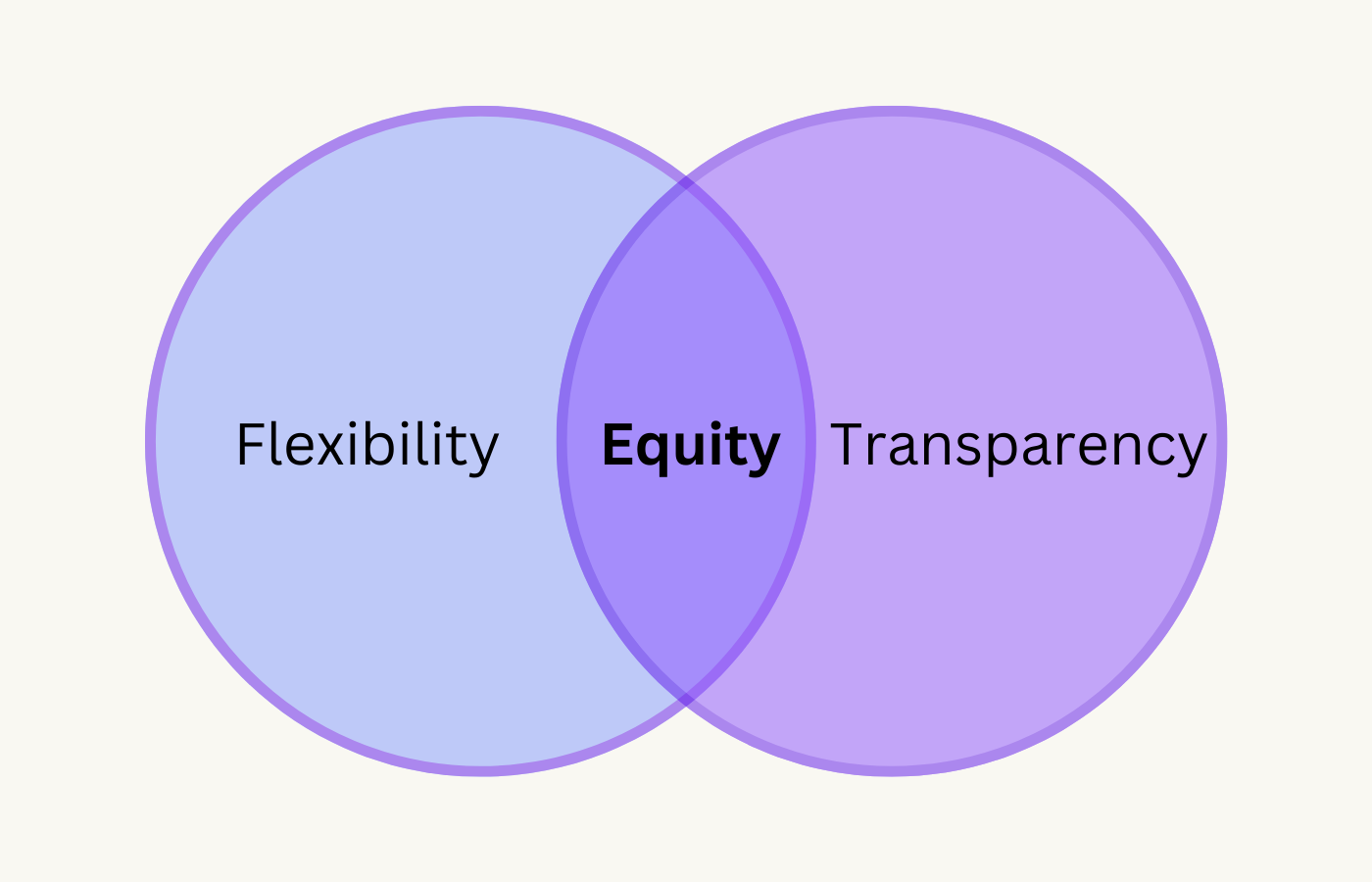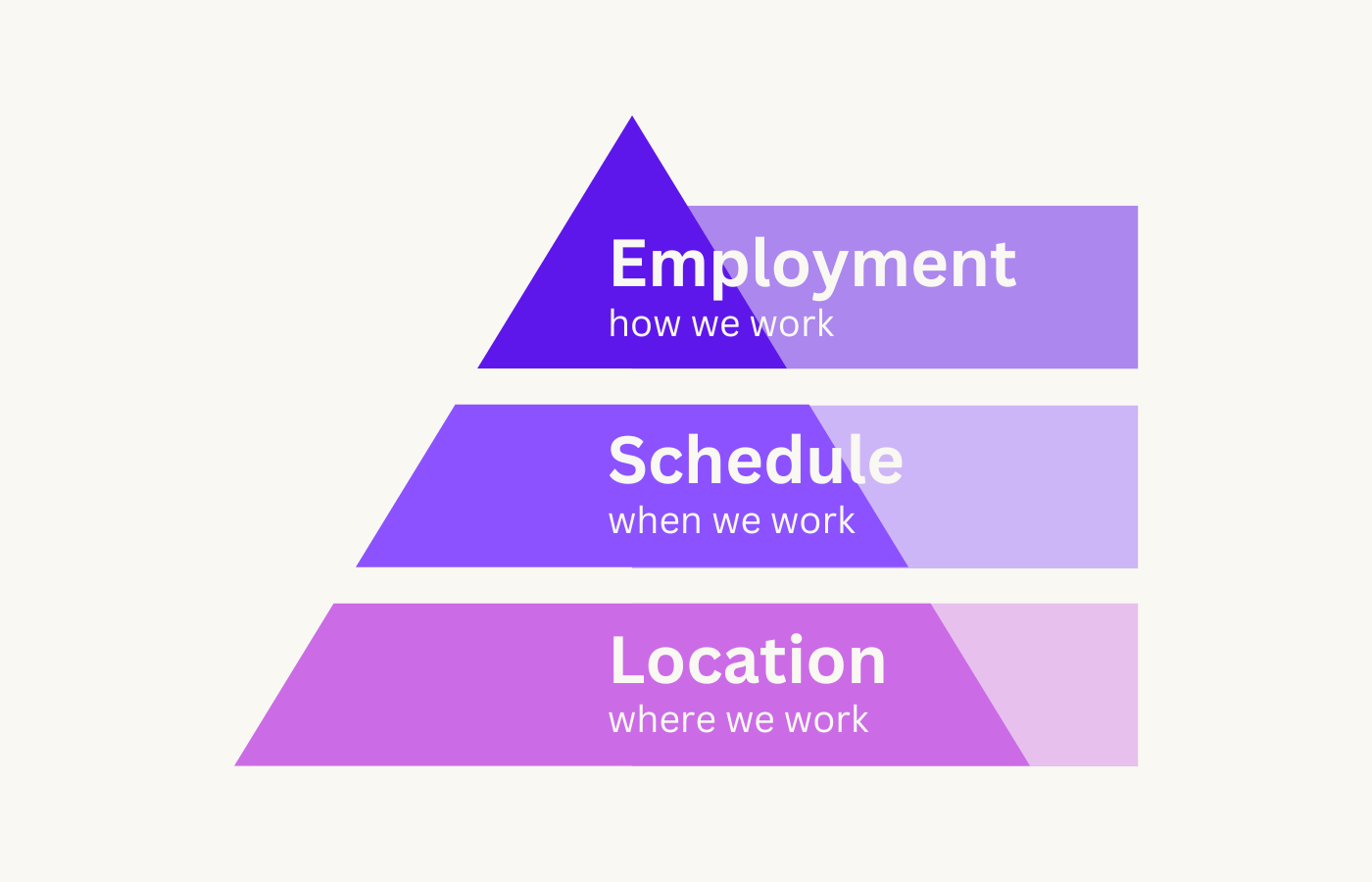003: The future of compensation is flexible (Part 1)
Why salary transparency isn't enough and the hierarchy of workplace flexibility needs.
As Millenials shed their chrysalises held together by overwork, burnout, and an elementary drive to be seen as top performers they are emerging with wings shaped by self-advocacy, realism, and refocused ambition. These wings are carried on the undercurrent blowing from Gen Z.
There is a shift happening in how people view the role of work in their lives.
I am a vocal advocate for pay transparency but I also think we’re missing the forest for the trees by narrowly focusing on salary range disclosure (I’ve done this too! See: List the damn salary range)
By centering the transparency conversation on one piece of compensation - base salary - we’re reinforcing out of date employment structures and missing out on an opportunity to design more inclusive systems that aren’t the same ol’ one-size-fits-all.
I believe the future of employment is flexible which necessites flexible compensation. In order to do that we need to pull back the curtain on all pieces of compensation.
Below, in Part 1 of this series, I cover:
How total compensation is stuck in the past
Shifts in our relationship with work
The hierarchy of workplace flexiblity needs
Total compensation is stuck in the past
For many, today’s total compensation structure is primarily entangled with individual career progression, reward, and recognition — overrotating toward motivators of a past way of working.
“In my 15 years of corporate life, climbing the career ladder was a natural goal for me. I kept going until I was burnt out and unhappy. Now, many would say I am a ‘dropout’ woman leader with a degree of disappointment. The disappointment is not in me but in the environment creating yet another dropout.”1
We’ve buit out career ladders and paths so it is clear how people can grow and advance in their role and earn higher pay. And so, as individuals, we follow the path of least resistance.
However, people making decisions about total compensation for employees often have a different set of rules and flexibility in what their own compensation looks like. They might be a founder who decided to go without a paycheck to maintain their number of shares or invest in a senior hire. Or, an executive team member who negotiated a base salary raise after closing a Series A.
They choose what they are motivated by and how their compensation aligns with their current stage in life.
I’m not arguing against career frameworks. Designing these is my primary type of work and an important step for offering salary and often equity transparency. But I think we should expand transparency to all pieces of total compensation so people fully understand each lever and can select the elements of total compensation that matter most to them.
Shifts in our relationship with work
We’ve seen that the historical pathways to promotion and the past ideations of success are flawed.
“My ambition hasn't changed. My willingness to sacrifice my personal well-being has. I'm no longer willing to risk my mental and physical health for a paycheck. Plus there are no clear career ladders for women. Why should we kill ourselves trying to bust through a glass ceiling?”
Clinging on to the structures of employment that have led us here will make retention an uphill battle. People are showing us through leaving tech, quiet quittting, taking two full time jobs, etc. that the current systems no longer work.
So, don’t try the same things we’ve always tried. Create a new system.
To understand how to structure total comp to align with today’s motivators, we have to get clear on what the motivators are. Beyond anthropod metaphors and antecdotes, we have stats speaking to a shift in people’s relationship with work:
Growth in independent workers: From 2020 to 2021, there was a 34% growth in independent workers. Of that 34%, 68% were Gen Z and Millenials and over half identify as women.
Expanding definition of flexibility: 80% of global desk-based workers say they want location flexibility, 94% say they want schedule flexibility (below we add employment flexibility 👇).
HR tech market growth: From 2021 to 2026, the HR tech market is expected to increase by $11.17 billion. These dollars are going into startups focused on employment flexibility like:
We also shouldn’t ignore the impact of layoffs. Whether you are just reading about layoffs, are still at an org that has gone through reductions, or have experienced it yourself, the constant news cyle about layoffs nurtures the seed of investing in yourself and making sure you aren’t relying on an organization.
By and large, people want choice over predetermined ways of working and a type of flexibility that expands past location and schedule.
This leads us to employment flexibility which brings this all together because choice about how you are employed is choice about how you are paid.
The hierarchy of workplace flexibility needs
Companies were nudged to move forward on location flexibility due to a global pandemic.
Right now, we’re talking a lot about schedule flexibility as a lever for inclusion and starting to collect data on this layer. The Future Forum’s October 2022 report details that workers who have full schedule flexibility are reporting 29% higher productivity and 53% greater ability to focus than workers with no ability to shift their schedule.
And, I think we’re just peeling back the layer of employment flexibility - a normalized path for flexibility in contractual employment agreement. Think: working as a contractor for 30 hours/week, job sharing, scaling from full time to part time in the summer, etc.
Flexibility shouldn’t just be about the schedule of hours you work but also how many hours you work and how you are compensated for them.
Why I choose employment flexibility
The best way I have found to manage my ADHD without burning out is consulting as a contractor. I love that consulting is focused on outcomes. I am in charge of setting my rate, negotiating if the pay is in cash or equity, sharing updates to relevant stakeholders, and the final deliverable. It is a clearer structure of the transactional nature of sharing my knowledge to help move a company forward.
This is just my experience but I have decided to work in this way because working as a contractor gives me flexibility to take on the projects I am most excited about. And, early-stage teams aren’t always ready for a full time People Ops team member. It is mutually beneficial.
Employment flexibility gives us the ability to ask: What components of total compensation matter most to you?
I believe employment and compensation flexibility is how we:
shape more inclusive and equitable teams by acknowleding that people have different needs, motivators, and priorties
better align and incentivize work tied to company and revenue goals
build better companies that aren’t limited by an outdated employee / employer relationship
Join me next week as I share how I would design a total compensation package with a new type of currency: flexibility.
Throughout this post I have included anonymous quotes from conversations I’ve had with people working in tech.




